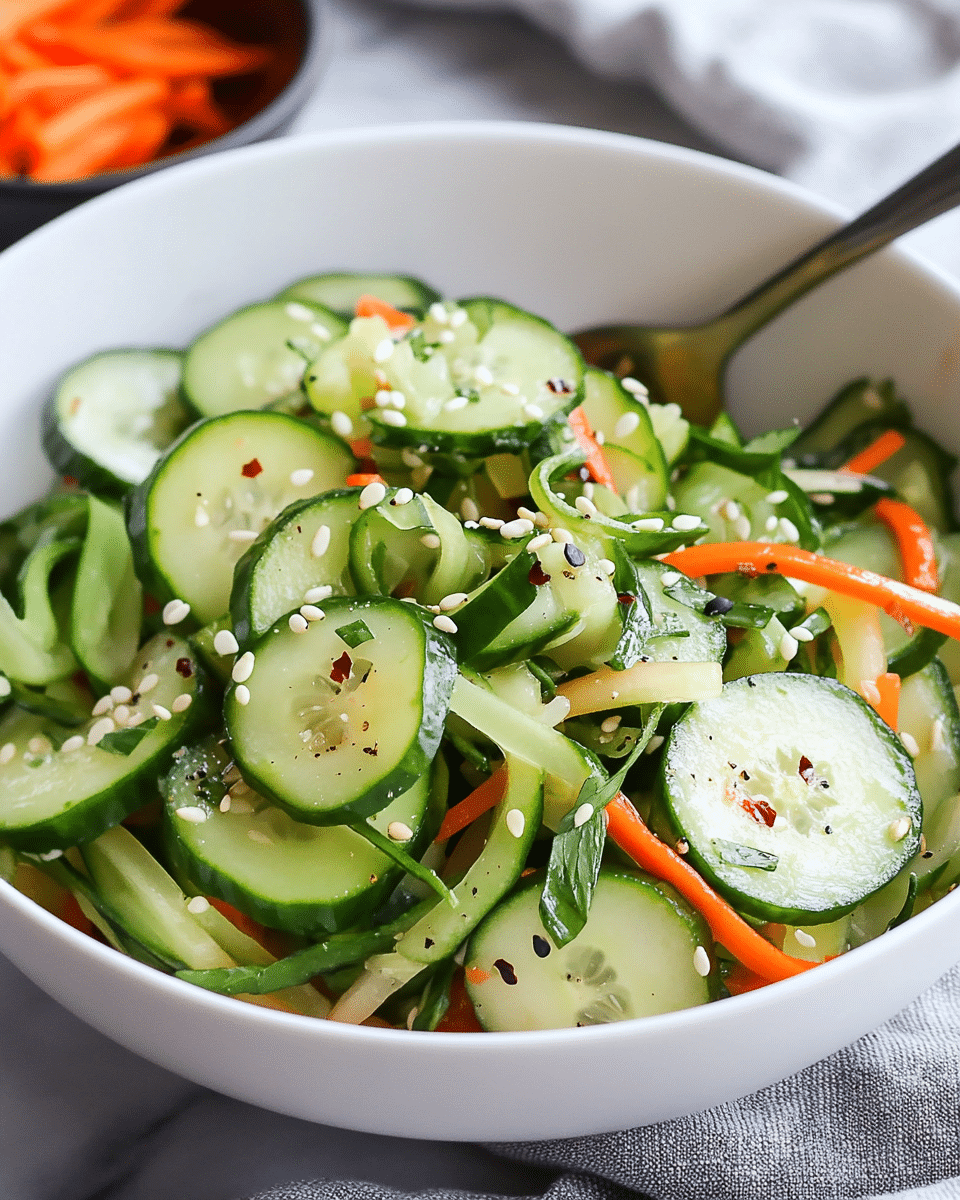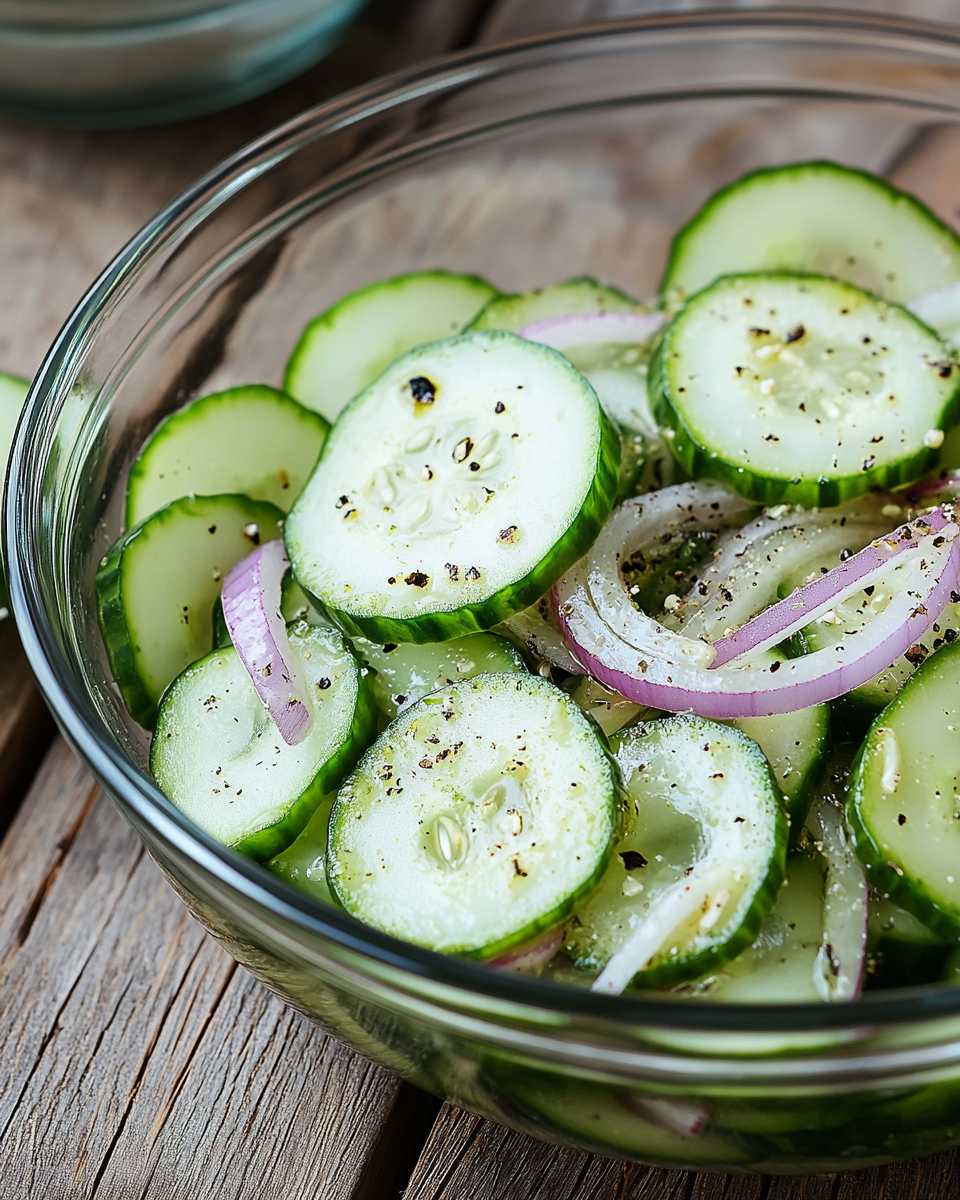A fresh, vibrant, and easy-to-make salad perfect for warm days or as a light side dish. This Cucumber Tomato Feta Salad combines crisp cucumbers, juicy tomatoes, and tangy feta cheese with a simple dressing for a refreshing Mediterranean-inspired flavor.
FULL RECIPE
Ingredients
- 2 cups cucumber, diced (about 1 large cucumber)
- 2 cups cherry tomatoes, halved
- 1 cup feta cheese, crumbled
- 1/4 cup red onion, thinly sliced
- 2 tablespoons fresh parsley, chopped
- 3 tablespoons extra virgin olive oil
- 1 tablespoon red wine vinegar
- 1 teaspoon dried oregano
- Salt and pepper, to taste
Directions
- In a large bowl, combine diced cucumber, halved cherry tomatoes, crumbled feta, sliced red onion, and chopped parsley.
- In a small bowl, whisk together olive oil, red wine vinegar, dried oregano, salt, and pepper.
- Pour the dressing over the salad and gently toss to combine all ingredients well.
- Refrigerate for 10-15 minutes before serving to let the flavors meld.
- Serve chilled as a side dish or a light lunch.
Nutritional Information
- Calories: 160 kcal
- Protein: 5 g
- Fat: 14 g
- Saturated Fat: 4 g
- Carbohydrates: 6 g
- Fiber: 2 g
- Sugars: 4 g
- Sodium: 350 mg
Health Benefits of Cucumber Tomato Feta Salad
This salad is a nutrient-dense dish loaded with vitamins and minerals. Cucumbers provide hydration and antioxidants, while tomatoes are a rich source of vitamin C, potassium, and lycopene, a powerful antioxidant linked to heart health. Feta cheese adds protein and calcium, contributing to bone strength. The olive oil dressing contains healthy monounsaturated fats that support heart health and reduce inflammation. Combined, these ingredients create a well-rounded dish that supports overall wellness.
Mediterranean Diet Connection
The Cucumber Tomato Feta Salad is a staple in Mediterranean cuisine, which is renowned for its heart-healthy properties. This diet emphasizes fresh vegetables, healthy fats like olive oil, moderate dairy consumption, and minimal processed foods. Eating meals inspired by Mediterranean flavors is associated with reduced risk of chronic diseases such as cardiovascular disease, diabetes, and certain cancers, making this salad both delicious and beneficial.
Versatility as a Meal or Side Dish
While often enjoyed as a side salad, this recipe can easily be turned into a light meal by adding ingredients such as grilled chicken, chickpeas, or quinoa. Its fresh flavors pair well with a variety of main dishes, from grilled fish and meats to vegetarian options. The simplicity and adaptability of the salad make it a go-to option for quick lunches or dinner accompaniments.
Seasonal and Fresh Ingredient Importance
Using fresh, in-season vegetables greatly enhances the flavor and nutritional value of this salad. Cucumbers and tomatoes at their peak provide the best texture and sweetness. Seasonal produce also tends to be more affordable and environmentally friendly. For the best results, choose ripe tomatoes that are fragrant and firm cucumbers that are crisp without any soft spots.
Feta Cheese: A Flavorful Dairy Choice
Feta cheese, a brined curd cheese, is known for its tangy, salty flavor that complements the mild vegetables perfectly. It is traditionally made from sheep’s or goat’s milk, which may be easier to digest for some people compared to cow’s milk cheese. Feta adds creaminess without overwhelming the salad, and its crumbly texture gives a pleasant contrast to the crunchy cucumbers and juicy tomatoes.
Olive Oil: The Heart of the Dressing
Extra virgin olive oil is the cornerstone of this salad’s dressing and is prized for its health benefits and rich flavor. It contains antioxidants and healthy fats that support cardiovascular health. Olive oil also enhances the absorption of fat-soluble vitamins from the vegetables. Choosing high-quality extra virgin olive oil elevates both taste and nutrition.
Cultural Significance and Origin
This salad has roots in the Mediterranean region, especially Greece, where fresh vegetables and cheeses are a fundamental part of daily eating. It reflects a culinary tradition that values simplicity and the natural flavors of high-quality ingredients. Sharing such dishes in social settings is common in Mediterranean cultures, emphasizing the role of food in community and family bonding.
Preparation Tips for Best Results
To maximize flavor, it’s recommended to prepare the salad shortly before serving. However, letting it chill for 10-15 minutes allows the dressing to infuse the vegetables and cheese. Cutting cucumbers and tomatoes into uniform pieces ensures consistent texture and easy eating. Adding herbs like parsley or oregano freshens the dish further. For an extra burst of flavor, a squeeze of lemon juice can be added just before serving.
Dietary Considerations and Adaptations
This salad is naturally gluten-free and vegetarian, making it suitable for many dietary preferences. For a vegan version, feta can be substituted with plant-based cheese alternatives or omitted entirely. Those watching sodium intake can reduce the amount of added salt or rinse the feta lightly to remove excess brine. It also fits well into low-carb and keto diets due to its emphasis on fresh vegetables and healthy fats.
Pairing Ideas with Drinks and Other Foods
Cucumber Tomato Feta Salad pairs beautifully with light and refreshing beverages such as iced herbal teas, crisp white wines like Sauvignon Blanc, or sparkling water with lemon. It complements Mediterranean dishes like grilled lamb, roasted vegetables, or stuffed grape leaves. For a casual meal, serve alongside warm pita bread or whole grain crackers to add texture and variety.
Storing and Leftover Tips
Because of its fresh ingredients, this salad is best enjoyed the same day it’s made. However, if you need to store leftovers, keep the dressing separate or add it just before eating to maintain crispness. Store in an airtight container in the refrigerator and consume within 1-2 days. The flavors may intensify overnight, but the cucumbers can become watery, so fresh preparation is preferred.
Environmental Impact of Ingredients
Choosing local and organic produce when possible can reduce the environmental footprint of this salad. Cucumbers and tomatoes grown in greenhouses or transported long distances may have higher carbon emissions. Olive oil production also varies in sustainability depending on farming practices. Supporting local farmers and seasonal buying encourages sustainable agriculture and fresher food.
Conclusion
The Cucumber Tomato Feta Salad is more than just a simple dish — it’s a flavorful, healthy, and culturally rich recipe that fits perfectly into a balanced diet. Its fresh ingredients and Mediterranean roots provide numerous health benefits while being easy to prepare and enjoy. Whether served as a side or a light meal, it offers versatility and freshness that appeal to a wide range of tastes and dietary needs. Embracing this salad means savoring a piece of Mediterranean tradition with every bite.








